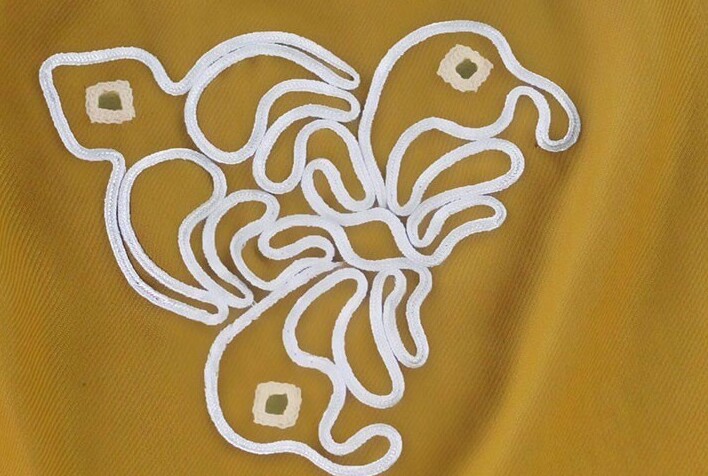What do you know about Qeytan Doozi? Join Saed News to learn more about this beautiful art.

What Do You Know About Qeytan Doozi?
Join Saed News to get familiar with this intricate art form.
Iran, a vast country with diverse customs and traditions, is home to many skilled women and men. Art has always been intertwined with the lives of Iranians. Among the many traditional crafts of this land, Qeytan Doozi holds a special place. The term “qeytan” refers to a thick metallic thread, usually more than one millimeter in diameter. The craft of sewing and attaching this thread to fabric in decorative patterns is known as Qeytan Doozi (braid embroidery).
Qeytan is a cord made from woven silk. Qeytan Doozi involves sewing this thick thread onto fabric to form decorative patterns. To add variety, colorful qeytans are used, particularly in specific regions. In some areas, however, the color of the qeytan and fabric may be the same. Qeytan comes in different types, including plain, twisted, split, coated, hooked, and ornamental varieties. Today, Qeytan Doozi is practiced in many parts of Iran, especially in the provinces of Khorasan, Mazandaran, Sistan and Baluchestan, Tehran, and East Azerbaijan.
In the past, Qeytan Doozi was highly popular, especially in preparing a bride’s dowry. Skilled women and girls used colorful silk threads to decorate various fabrics. Wide and narrow braids made of metallic threads (golabetoon) were used as borders or trims on women’s trousers, headbands, and more. Entire men's and women’s garments were often beautifully adorned with Qeytan Doozi.

As hand embroidery takes a long time and handmade items cannot meet modern market demands, special presser feet for Qeytan Doozi are now used with industrial sewing machines. This type of embroidery is commonly seen on garments, cushions, bedspreads, traditional clothing, and more. The special sewing machine foot has three grooves to hold the qeytans in place.
The designs used in Qeytan Doozi include flowers, paisleys (boteh jegheh), symbolic motifs, and geometric patterns. Qeytan Doozi adds unique elegance to garment borders such as manteaux, blouses, and sleeves. Sometimes, qeytan threads are sewn onto gathered or plain tulle fabrics. Either contrasting or matching thread and fabric colors may be used. Velvet, broadcloth, satin, termeh, suede, or medium-thickness fabrics are ideal for this technique.
Frequently used motifs include flowers, bushes, symbolic patterns, various paisleys, and geometric designs. In Khorasan Province, machine Qeytan Doozi is especially common due to the time-consuming nature of handwork. This craft is often used for items like Quran covers, cloth wrappers (boqcheh), clothing embellishments, prayer rugs, and cushion covers. To enhance the appearance of the embroidery, fine silver or gold golabetoon thread can be added. In many regions, Qeytan Doozi is done alongside mirror work (ayneh doozi).

First, choose a continuous pattern that starts and ends at the same point.
Use carbon paper to transfer the design onto the fabric.
Use a hook to pull the qeytan thread through to the underside of the fabric.
Thread a needle with sewing thread that matches the qeytan (not the fabric).
From the back, secure the qeytan with a small stitch to keep it in place. To prevent fraying, burn the tip of the thread with a lighter or match.
Finally, stitch along the center of the qeytan in short, closely spaced slant stitches to complete the design.
Various types of qeytan (braid cord)
Needle
Thread matching the qeytan
Velvet or broadcloth (commonly in green, burgundy, black, purple, or white)
Large needle or crochet hook
In this article, we explored the art of Qeytan Doozi. Hopefully, this traditional craft inspires you to create beautiful handmade items using this intricate and timeless technique.

